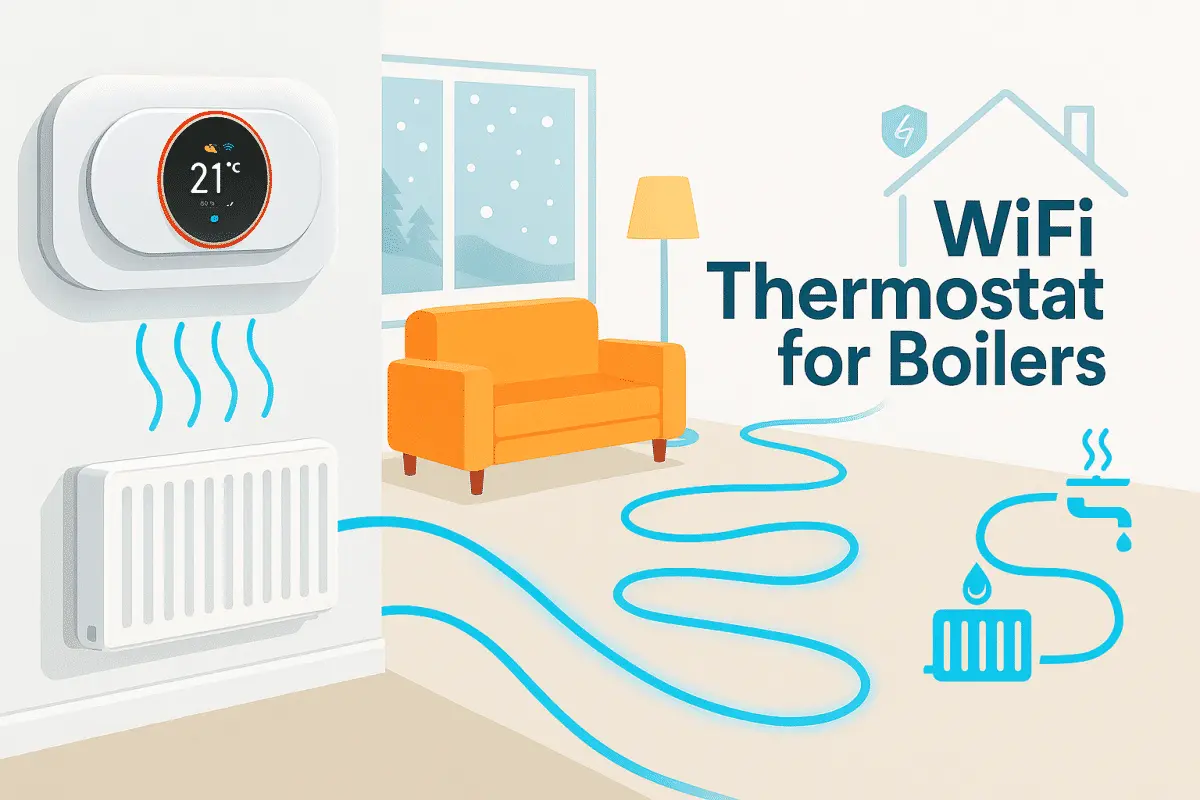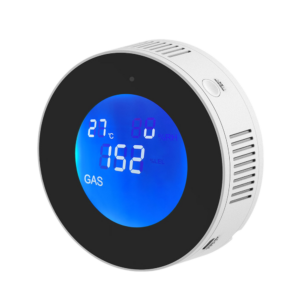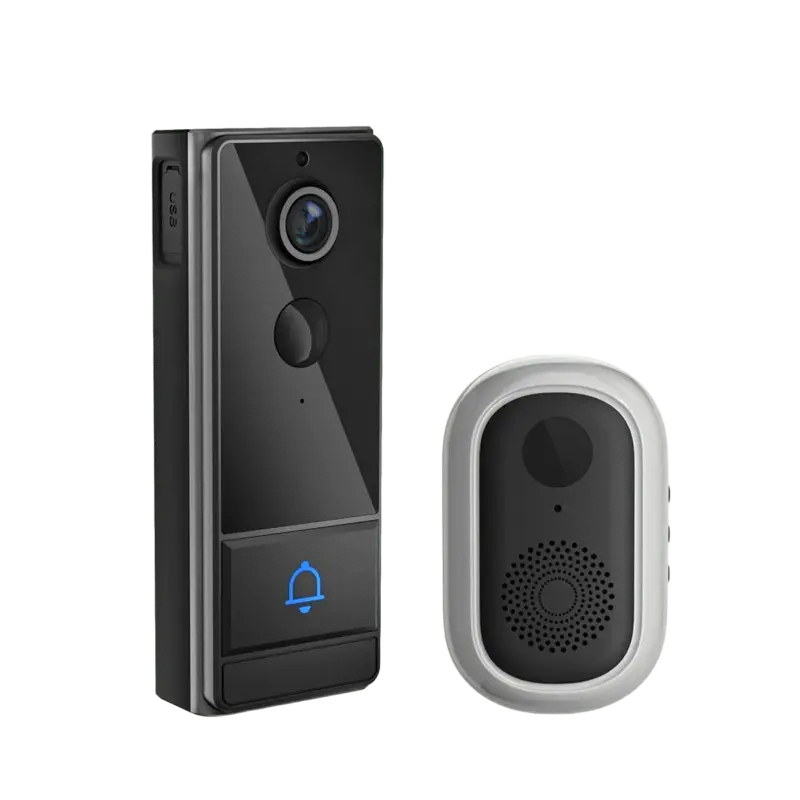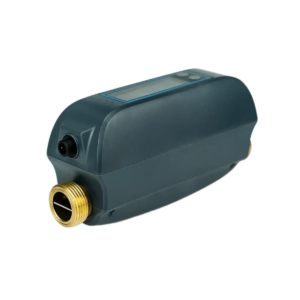Installing a WiFi thermostat for boilers allows homeowners to control heating remotely, reduce energy bills, and maintain consistent comfort across every room.
Smart thermostats learn your routine, adjust automatically, and make boiler heating far more efficient than traditional systems.
They combine WiFi connectivity, adaptive scheduling, and precision temperature control to balance energy use and comfort effortlessly.
With models like Grus EcoNet-BH, managing your boiler becomes as simple as checking your phone.
Introduction: The Smart Way to Manage Boiler Heating
Boilers have long been the backbone of home heating systems in Europe and North America. From traditional gas-fired models to modern electric or oil systems, they provide steady and uniform warmth during the coldest months. Yet despite their reliability, one critical component often lags behind — the thermostat.
Older thermostats operate with simple mechanical switches. They react slowly to temperature changes, offer no scheduling, and certainly no remote access.
As energy prices rise and sustainability becomes a household priority, homeowners are demanding smarter, more efficient heating control. This shift has led to the rise of WiFi thermostats for boilers, bringing intelligence and precision into a once purely mechanical system.
Unlike analog thermostats that simply turn the boiler on or off, WiFi thermostats use real-time sensors and data-driven algorithms to fine-tune heating output.
They don’t just measure — they predict.
For example, when outdoor temperatures begin to drop, a smart thermostat can preheat your home before you arrive, ensuring comfort without wasting energy.
Imagine controlling your heating from anywhere — your phone, tablet, or even voice assistant.
Whether you’re coming home from work early or away on vacation, you can adjust, schedule, and monitor your boiler remotely.
No more coming home to a cold house, and no more wasted heat when nobody’s there.
According to the U.S. Department of Energy, properly configured smart thermostats can reduce annual heating energy use by 10–20%. When integrated into boiler-based systems, that translates to hundreds of dollars in savings per household — and a smaller carbon footprint.
For many homeowners, upgrading to a WiFi thermostat is the simplest, fastest way to make an old heating system feel brand-new.
How WiFi Thermostats Work with Boilers
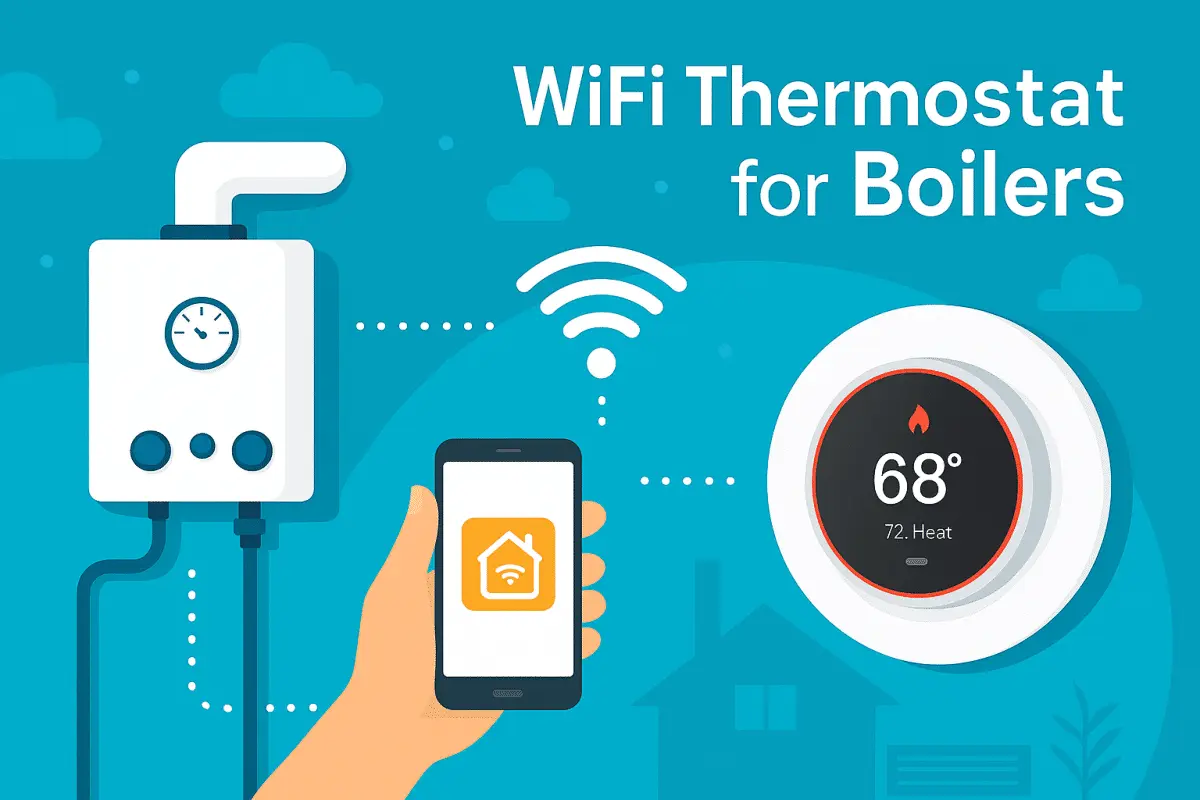
At their core, WiFi thermostats act as the intelligent “brain” of your boiler heating system.
They regulate when and how your boiler activates — based on real-time temperature, humidity, and sometimes even your occupancy habits.
A typical system operates through a relay connection, sending on/off signals to your boiler’s control circuit. Some modern models use modulating control, which allows more gradual, precise heating instead of full power bursts.
Here’s how the process works:
- Sensors Measure Room Temperature The thermostat constantly measures ambient temperature and compares it to your setpoint (the target temperature).
- Decision Logic via Algorithm Instead of a simple on/off switch, smart thermostats calculate heat demand using algorithms that account for room size, insulation, and heat loss rate.
- Signal Transmission via WiFi When adjustment is needed, the thermostat sends a command through your home WiFi or Zigbee network, activating the boiler control relay.
- System Feedback & Learning The thermostat monitors how long it takes for the room to reach the target temperature and adjusts its future response time accordingly — a process known as adaptive learning.
- Cloud and App Integration All operations are mirrored in a mobile app or cloud dashboard, allowing you to see real-time temperature data, energy use, and performance graphs.
Here’s a simple flow of how it all connects:
--- title: "Smart Heating Control Flow (App → Thermostat → Boiler)" --- graph TD %% ===== Styles ===== classDef user fill:#FDE7EC,stroke:#C2185B,stroke-width:2,rx:10,ry:10,color:#880E4F,font-weight:bold; classDef cloud fill:#E3F2FD,stroke:#1E88E5,stroke-width:2,rx:10,ry:10,color:#0D47A1,font-weight:bold; classDef device fill:#FFF4C2,stroke:#F4A300,stroke-width:2,rx:10,ry:10,color:#5D4037,font-weight:bold; classDef relay fill:#FFE9D6,stroke:#E67E22,stroke-width:2,rx:10,ry:10,color:#6E2C00,font-weight:bold; classDef system fill:#E2F7E2,stroke:#2E7D32,stroke-width:2,rx:10,ry:10,color:#1B5E20,font-weight:bold; classDef sensor fill:#E8D9FF,stroke:#8E24AA,stroke-width:2,rx:10,ry:10,color:#4A148C,font-weight:bold; %% ===== Nodes ===== A["📱 Mobile App / 🗣️ Voice Assistant"]:::user B["☁️ Cloud Service<br/>Control Logic & Schedules"]:::cloud C["🌡️ Wi-Fi Smart Thermostat"]:::device D["⚡ Boiler Control Relay"]:::relay E["🔥 Heating System<br/>(Radiators / Floor Heating)"]:::system F["🌬️ Room Temperature Feedback"]:::sensor %% ===== Flow ===== A -->|"User sets temperature / voice command"| B B -->|"Remote control signals"| C C -->|"Heating ON/OFF command"| D D -->|"Activate heating system"| E E -->|"Room temperature increases"| F F -->|"Real-time temperature feedback"| C
This integration creates a continuous feedback loop between your home’s heating system and your digital interface — ensuring optimal performance and comfort.
Compatibility Factors
Before choosing a WiFi thermostat, compatibility with your boiler system is critical.
Boilers may use low-voltage (24V) or line-voltage (120–240V) wiring. Some older models use proprietary control interfaces that require adapters or specific thermostats.
Smart thermostats like Grus EcoNet-BH are designed to handle both standard line-voltage baseboard systems and boiler relay controls, making them versatile for diverse installations.
Other factors to consider:
- Number of Zones – Multi-zone heating requires individual thermostat control or smart zoning modules.
- Modulating vs On/Off – High-efficiency boilers (condensing type) perform best with modulating thermostats.
- WiFi Coverage – Strong signal near the thermostat ensures smooth operation and real-time response.
In short, a WiFi thermostat doesn’t just make your heating more convenient — it transforms your boiler into a smart heating system capable of predicting, adapting, and optimizing.
Why Choose a Smart Boiler Thermostat
Traditional thermostats can’t adapt to the way your household actually uses heat.
They turn the boiler on and off at fixed points — regardless of weather, occupancy, or real-time comfort.
A WiFi thermostat for boilers, on the other hand, delivers data-driven precision and control, turning your heating into an intelligent energy management system.
Here’s why it’s a smart investment for 2025 homes:
1. Remote Control, Real Comfort
Whether you’re at work or on vacation, you can adjust your heating instantly through your phone.
Cold front approaching? Turn the heat on early. Forgot to lower the temperature before leaving? Do it remotely in seconds.
Smart thermostats connect to the cloud and your home WiFi, ensuring 24/7 access.
2. Intelligent Scheduling
Unlike mechanical timers, WiFi thermostats learn your patterns.
They automatically preheat before you wake up and reduce output when everyone’s out.
Adaptive scheduling can save 10–20% annually by avoiding unnecessary heating cycles.
Source: Energy Saving Trust, UK, 2024.
3. Zonal Control and Balance
Boiler systems often heat multiple zones — bedrooms, living spaces, or bathrooms — with separate loops.
A smart thermostat network can manage each zone independently, maintaining comfort everywhere without overheating empty rooms.
For example, a system using Grus EcoNet-BH thermostats in a 3-zone boiler setup reduced total run-time by 18% while improving comfort consistency across the home.
4. Integration with Smart Home Platforms
Most WiFi thermostats support Alexa, Google Assistant, or Apple HomeKit, allowing voice control or automation scenes.
For instance:
“Hey Google, set boiler temperature to 21 degrees.”
or
“Alexa, turn down heating when I leave home.”
5. Energy Insights and Reporting
Smart thermostats generate energy usage reports, showing trends over time.
You can view how much energy each zone consumes and identify inefficient patterns — turning invisible waste into actionable data.
| Feature | Description | User Benefit |
|---|---|---|
| Remote Access | Adjust from anywhere | Comfort on demand |
| Learning Schedule | Auto-optimizes timing | Reduced heating cost |
| Zonal Control | Manage each area independently | Balanced warmth |
| App Integration | Works with voice and app | Simpler user experience |
| Energy Reports | Shows real-time & historical data | Informed energy savings |
Compatibility and Installation Tips
Boiler systems vary widely across homes — from old single-stage units to advanced condensing systems.
Choosing a compatible WiFi thermostat ensures safe, reliable operation.
Voltage Type
- Low-Voltage (24V): Common in gas and oil boilers using control relays.
- Line-Voltage (120/240V): Found in electric or hydronic baseboard heating systems. Make sure your thermostat supports the same voltage category.
EcoNet-BH supports both line-voltage and relay-based boiler connections, offering wide compatibility without complex rewiring.
Wiring Considerations
- C-wire (common wire) may be required for WiFi thermostats to power the electronics.
- If unavailable, many models (like EcoNet-BH) include internal power modules or can draw current directly from the relay circuit.
Placement & Environment
- Install at chest height (~1.5m) away from direct heat sources or cold drafts.
- Avoid placing near windows or air vents.
- For radiant or baseboard heating, use multiple thermostats across zones for even distribution.
App Setup
- After physical installation, pair the thermostat with the Grus App or compatible platform.
- Connect to your WiFi, assign zone names, and set initial schedules.
- Run a calibration test to ensure accurate temperature readings.
For full installation instructions, visit
Best WiFi Thermostat Models for Boilers in 2025
Below is a comparison of top-performing thermostats for boiler systems in 2025:
| Model | Voltage Type | Connectivity | Notable Features | Ideal For |
|---|---|---|---|---|
| Grus EcoNet-BH | 120/240V or Relay | WiFi | Adaptive scheduling, energy reports, line-voltage support | Electric or hydronic baseboards, boilers |
| Honeywell Home T9 | 24V | WiFi + Sensors | Multi-room sensing, mobile alerts, geofencing | Central heating with multiple zones |
| Nest Learning Thermostat (4th Gen) | 24V | WiFi | AI learning, auto-away, HVAC energy charts | Mixed HVAC + boiler systems |
| tado° Smart Thermostat V3+ | 24V | WiFi + Geolocation | Room-by-room smart zoning, open window detection | Radiator & central boiler homes |
| Ecobee Smart Thermostat Premium | 24V | WiFi + SmartSensors | Occupancy detection, advanced reporting | Multi-zone boiler or mixed systems |
Each model excels in different aspects.
The EcoNet-BH stands out for line-voltage compatibility — an area where most popular thermostats still fall short.
This makes it especially practical for hybrid systems that use both boilers and electric baseboards.
Real-World Case Study: Upgrading a 10-Year-Old Gas Boiler
To see how these thermostats perform in the real world, let’s look at a retrofit project from Manchester, UK.
Background:
A homeowner with a 10-year-old gas boiler and two mechanical thermostats was facing inconsistent temperatures — upstairs too hot, downstairs too cold — and high winter bills.
The Upgrade:
The system was replaced with two EcoNet-BH WiFi thermostats, each controlling a separate zone through relay wiring.
Integration with the WattPanel-2X allowed real-time tracking of electricity draw from pumps and controls.
Results After 2 Months:
- Average indoor temperature variation dropped from ±2.5 °C to ±0.4 °C.
- Boiler runtime decreased by 17%, saving roughly £30/month in gas.
- Comfort score (based on user feedback) increased from 6.8 to 9.3.
- The app-based remote scheduling was the most praised feature, especially for vacation mode.
“The biggest change wasn’t just lower bills — it was consistency. The house feels the same temperature everywhere, all the time,” says homeowner T. Collins.
This case highlights how WiFi thermostats provide both measurable energy benefits and a better living experience — transforming even an aging boiler into a responsive, modern system.
Integration with Smart Systems: From Boiler to Whole-Home Control
WiFi thermostats do more than just manage temperature — they’re the gateway to full home energy automation.
When combined with other smart systems, your boiler becomes part of a unified energy network that responds to real-time conditions.
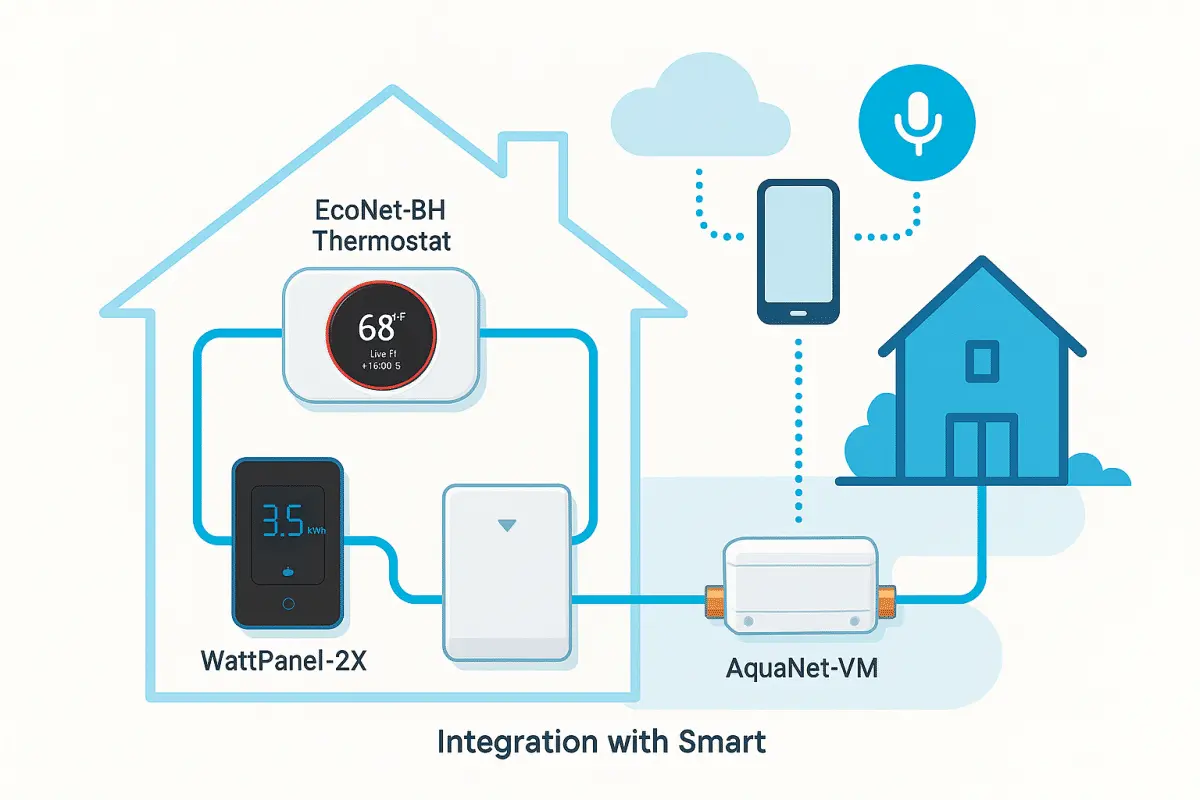
🔹 Integration with WattPanel-2X: Energy Awareness
The WattPanel-2X from Grus.io measures split-phase power usage in real time, allowing you to see exactly how much energy your boiler, circulation pump, or backup heater consumes.
Data from the thermostat and energy monitor can be combined to optimize heating cycles.
For instance:
- When power draw spikes due to heating demand, the system can automatically reduce non-critical loads.
- During off-peak hours, the thermostat pre-heats zones to take advantage of lower energy rates.
🔹 Integration with AquaNet-VM: Safety and Protection
Boiler systems depend on water circulation — which makes leak detection and pressure monitoring vital.
The AquaNet-VM smart valve integrates with EcoNet-BH thermostats, creating a safety layer that automatically shuts off water flow in case of leaks or overpressure events.
This coordination prevents costly water damage, especially in basements or boiler rooms.
🔹 Cloud & Voice Assistant Ecosystem
EcoNet-BH thermostats are compatible with:
- Google Home
- Amazon Alexa
- Apple HomeKit
- Home Assistant (via Grus API)
This means your heating can work alongside lighting, security, and energy systems — all through a single interface.
For example:
“Alexa, I’m going to bed” → lowers boiler temperature to night mode and turns off main lighting.
These integrations make heating control not just smart — but context-aware, responding to how you actually live.
🔹 Automation Example
--- title: "Grus Smart Home Energy + Water Safety Architecture" --- graph TD %% ===== Styles ===== classDef thermo fill:#FFF4C2,stroke:#F4A300,stroke-width:2,rx:10,ry:10,color:#5D4037,font-weight:bold; classDef energy fill:#E0F7FA,stroke:#00838F,stroke-width:2,rx:10,ry:10,color:#004D40,font-weight:bold; classDef water fill:#FFE9D6,stroke:#E67E22,stroke-width:2,rx:10,ry:10,color:#6E2C00,font-weight:bold; classDef cloud fill:#E2F7E2,stroke:#2E7D32,stroke-width:2,rx:10,ry:10,color:#1B5E20,font-weight:bold; classDef app fill:#FDE7EC,stroke:#C2185B,stroke-width:2,rx:10,ry:10,color:#880E4F,font-weight:bold; %% ===== Nodes ===== A["🌡️ EcoNet-BH Smart Thermostat"]:::thermo B["⚡ WattPanel-2X<br/>Energy Monitor"]:::energy C["🚰 AquaNet-VM<br/>Smart Water Valve"]:::water D["☁️ Grus Cloud Dashboard<br/>Energy & Water Intelligence"]:::cloud E["📱 User App + 🗣️ Voice Assistants"]:::app %% ===== Flow ===== A -->|"Home Heating Data"| B A -->|"HVAC Safety / Shutoff"| C B -->|"Energy Insights"| D C -->|"Water Safety Events"| D D -->|"Dashboards / Alerts"| E E -->|"Remote Control / Commands"| A
This ecosystem demonstrates how Grus devices create a feedback-driven home energy network — monitoring, optimizing, and protecting simultaneously.
Frequently Asked Questions
Q1: Can I install a WiFi thermostat myself?
Most WiFi thermostats can be installed by homeowners in under 30 minutes.
If you’re connecting to a low-voltage (24V) boiler, follow the wiring guide carefully. For high-voltage systems, a licensed electrician is recommended.
Q2: What if my WiFi goes offline?
All Grus thermostats operate locally. They store your schedules and continue functioning normally. Once the connection is restored, the system syncs data automatically.
Q3: How much energy can a WiFi thermostat really save?
Energy reduction depends on home insulation and usage patterns.
On average, smart thermostats reduce annual heating consumption by 10–25%, according to DOE and field studies by Grus.io.
Q4: Does it work with old boilers?
Yes — as long as your boiler uses standard relay or 24V control.
EcoNet-BH supports retrofit wiring and can replace most analog thermostats directly.
Q5: Can it integrate with solar or heat pump systems?
Yes. EcoNet-BH supports hybrid configurations, switching seamlessly between boiler and heat pump operation based on outdoor temperature or energy price signals.
The Future of Heating: Efficiency Meets Intelligence
As global energy standards tighten and carbon reduction becomes central to household policy, heating systems are evolving from reactive to predictive.
Tomorrow’s boiler control will no longer depend on manual input — it will anticipate user needs, adapt to energy prices, and optimize based on weather data.
Smart thermostats like EcoNet-BH are the first step in that transition.
They transform traditional boilers into data-driven, connected heating hubs that communicate with every part of your home.
Imagine:
- Your thermostat receives a signal from your local grid that energy prices will drop overnight.
- It preheats the house before dawn to use cheaper electricity.
- Meanwhile, your WattPanel-2X tracks power flow and the AquaNet-VM monitors for safety — all automatically.
That’s the reality of AI-assisted home heating — comfort without waste, intelligence without complexity.
Key Takeaway
A WiFi thermostat isn’t just a convenience upgrade — it’s an energy strategy.
By combining automation, connectivity, and data, it helps households achieve comfort, control, and conservation — the new “three Cs” of modern living.
Smarter Heating, Trusted Technology
For over a decade, Grus.io has focused on smart energy and safety automation for homes across North America and Europe.
Its engineering team collaborates with HVAC professionals and environmental engineers to build reliable, field-tested solutions that integrate seamlessly into real homes.
From EcoNet-BH smart thermostats to AquaNet-VM leak protection and WattPanel-2X energy monitoring, every Grus product is designed with one goal:
to make energy management simple, measurable, and safe for everyone.
When you choose Grus, you’re not just buying a thermostat — you’re building a foundation for a connected, efficient, and sustainable home.
Learn how baseboard, heat pump, and HVAC smart thermostats work — plus setup tips and energy-saving strategies.
Read the Smart Thermostat Heating Guide →